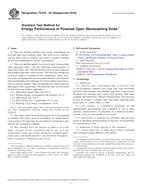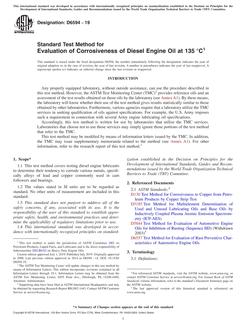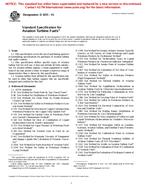1.1 This test method covers an engine test procedure for the measurement of the effects of automotive engine oils on the fuel economy of passenger cars and light-duty 3856 kg (8500 lb), or less, gross vehicle weight trucks. The tests are conducted using a specified 4.6-L spark-ignition engine on a dynamometer test stand. It applies to multiviscosity grade oils used in these applications. Companion test methods used to evaluate engine oil performance for specification requirements are discussed in the latest revision of Specification D4485.
1.2 The values stated in either SI units or other units shall be regarded separately as the standard. Within the text, the SI units are stated first with the other units shown in parentheses. The values stated in each system may not be exact equivalents; therefore, each system shall be used independently of the other, without combining values in any way.
1.3This standard does not purport to address all of the safety concerns, if any, associated with its use. It is the responsibility of the user of this standard to establish appropriate safety and health practices and determine the applicability of regulatory limitations prior to use.
1.4 This test method is arranged as follows:
| Subject | Section |
| Introduction | |
| Scope | 1 |
| Referenced Documents | 2 |
| Terminology | 3 |
| Summary of Test Method | 4 |
| Significance and Use | 5 |
| Apparatus | 6 |
| General | 6.1 |
| Test Engine Configuration | 6.2 |
| Laboratory Ambient Conditions | 6.3 |
| Engine Speed and Load Control | 6.4 |
| Engine Cooling System | 6.5 |
| External Oil System | 6.6 |
| Fuel System | 6.7 |
| Engine Intake Air Supply | 6.8 |
| Temperature Measurement | 6.9 |
| AFR Determination | 6.10 |
| Exhaust and Exhaust Back Pressure Systems | 6.11 |
| Pressure Measurement and Pressure Sensor Locations | 6.12 |
| Engine Hardware and Related Apparatus | 6.13 |
| Miscellaneous Apparatus Related to Engine Operation | 6.14 |
| Reagents and Materials | 7 |
| Engine Oil | 7.1 |
| Test Fuel | 7.2 |
| Engine Coolant | 7.3 |
| Cleaning Materials | 7.4 |
| Sealing Compounds | 7.5 |
| Preparation of Apparatus | 8 |
| Test Stand Preparation | 8.2 |
| Engine Preparation | 9 |
| Cleaning of Engine Parts | 9.2 |
| Engine Assembly Procedure | 9.3 |
| General Assembly Instructions | 9.3.1 |
| Bolt Torque Specifications | 9.3.2 |
| Sealing Compounds | 9.3.3 |
| New Parts Required for Each New Engine | 9.3.4 |
| Harmonic Balancer | 9.3.5 |
| Oil Pan | 9.3.6 |
| Intake Manifold | 9.3.7 |
| Camshaft Covers | 9.3.8 |
| Thermostat | 9.3.9 |
| Thermostat Housing | 9.3.10 |
| Coolant Inlet | 9.3.11 |
| Oil Filter Adapter | 9.3.12 |
| Dipstick Tube | 9.3.13 |
| Water Pump | 9.3.14 |
| Sensors, Switches, Valves, and Positioners | 9.3.15 |
| Ignition System | 9.3.16 |
| Fuel Injection System | 9.3.17 |
| Intake Air System | 9.3.18 |
| Engine Management System (Spark and Fuel Control) | 9.3.19 |
| Accessory Drive Units | 9.3.20 |
| Exhaust Manifolds | 9.3.21 |
| Engine Flywheel and Guards | 9.3.22 |
| Lifting of Assembled Engines | 9.3.23 |
| Engine Mounts | 9.3.24 |
| Calibration | 10 |
| BC Pre-Test Verification | 10.1 |
| Engine/Test Stand Calibration | 10.2 |
| Procedure | 10.2.1 |
| Reporting of Reference Results | 10.2.2 |
| Analysis of Reference Oils | 10.2.3 |
| Flush Effectiveness Demonstration | 10.2.4 |
| Instrument Calibration | 10.3 |
| Engine Load Measurement System | 10.3.1 |
| Fuel Flow Measurement System | 10.3.2 |
| Coolant Flow Measurement System | 10.3.3 |
| Thermocouple and Temperature Measurement System | 10.3.4 |
| Humidity Measurement System | 10.3.5 |
| Other Instrumentation | 10.3.6 |
| Test Procedure | 11 |
| Preparation for Initial Start-Up of New Engine | 11.1 |
| Initial Engine Start-Up | 11.2 |
| Coolant Flush | 11.3 |
| New Engine Break-In | 11.4 |
| Routine Test Operation | 11.5 |
| Start-Up and Shutdown Procedures | 11.5.8 |
| Flying Flush Oil Exchange Procedures | 11.5.9 |
| Test Operating Stages | 11.5.10 |
| Stabilization to Stage Conditions | 11.5.11 |
| Stabilized BSFC Measurement Cycle | 11.5.12 |
| Data Logging | 11.5.13 |
| BC Oil Flush Procedure for BC Oil Before Test Oil | 11.5.14 |
| BSFC Measurement of BC Oil Before Test Oil | 11.5.15 |
| Test Oil Flush Procedure | 11.5.16 |
| Test Oil Aging | 11.5.17 |
| BSFC Measurement of Aged Test Oil | 11.5.18 |
| BC Oil Flush Procedure for BC Oil After Test Oil | 11.5.19 |
| BSFC Measurement for BC Oil After Test Oil | 11.5.20 |
| General Test Data Logging Forms | 11.5.21 |
| Diagnostic Review Procedures | 11.5.22 |
| Determination of Test Results | 12 |
| Final Test Report | 13 |
| Validity Statement | 13.1 |
| Report Format | 13.2 |
| Precision, Validity, and Bias | 14 |
| Precision | 14.1 |
| Validity | 14.2 |
| Test Stand Calibration Status | 14.2.1 |
| Validity Interpretation of Deviant Operational Conditions | 14.2.2 |
| Keywords | 15 |
| ANNEXES | |
| Role of ASTM Test Monitoring Center | Annex A1 |
| Detailed Specifications and Drawings of Apparatus | Annex A2 |
| Oil Heater Cerrobase Refill Procedure | Annex A3 |
| Engine Part Number Listing | Annex A4 |
| Flying Flush Checklists | Annex A5 |
| Safety Precautions | Annex A6 |
| Report Format | Annex A7 |
| Control Chart Technique for Stand/Engine Severity Adjustment (SA) | Annex A8 |
| Statistical Equations for Mean and Standard Deviation | Annex A9 |
| Fuel Injector Evaluation | Annex A10 |
| Pre-test Maintenance Checklist | Annex A11 |
| APPENDIXES | |
| Procurement of Test Materials | Appendix X1 |
| Data Dictionary | Appendix X2 |
Product Details
- Published:
- 01/01/2000
- Number of Pages:
- 84
- File Size:
- 1 file , 2.1 MB


